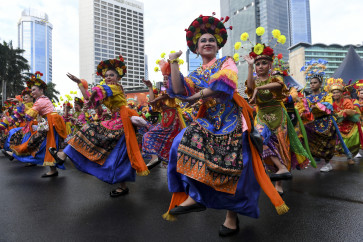Popular Reads
Top Results
Can't find what you're looking for?
View all search resultsPopular Reads
Top Results
Can't find what you're looking for?
View all search results‘Mayday, mayday, mayday!’ for workers on May Day
You’re all familiar with the distress signal mayday, mayday, mayday used by aviators and mariners right? Yes, it has to be said three times in a row!As May 1 approached, I thought I’d find out what the origin of this distress signal was
Change text size
Gift Premium Articles
to Anyone
Y
ou’re all familiar with the distress signal mayday, mayday, mayday used by aviators and mariners right? Yes, it has to be said three times in a row!
As May 1 approached, I thought I’d find out what the origin of this distress signal was. Did it have anything to do with May Day, the popular name for International Labor Day, celebrated on May 1 every year?
As it turns out, it comes from the French m’aider (help me) short for venezm’aider (come help me). In 1923, a senior radio officer in Croydon Airport, London, suggested this anglicized version of m’aider because the traffic between his airport and Le Bourget Airport in Paris was so heavy.
So what is International Labor Day about?
From the late 19th century, labor movements and trade unions were looking for a day to celebrate workers’ achievements: the eight-hour day, 40-hour week. The rest of the day was for rest and recreation, divided into eight hours each. Seems reasonable right?
But before working hours were regulated, during the Industrial Revolution in Britain (1760 to about 1820/1840), a working day could be anything between 10 to 16 hours, six days a week! So karoshi (death by overworking) wasn’t invented by the Japanese in 1969, but long before.
In the end, May 1 was chosen to commemorate the Haymarket Affair in 1886 when someone threw a bomb to disperse a labor demonstration. Eight policemen and four civilians died, while many more were injured.
The Haymarket Affair actually happened on May 4, but May 1 was chosen as Labor Day because it’s also an ancient northern hemisphere spring festival. Some countries celebrate Labor Day on different dates, depending on the history of the workers’ movement in their specific country.
Nevertheless, May 1 is internationally recognized as International Labor Day and is a public holiday in many countries, and since 2014, also in Indonesia.
In the 21st century, is the celebration of May Day still justified? To find out, I decided to attend the Festival Pekerja (Workers’ Festival) held at the increasingly dilapidated Jakarta Legal Aid (LBH) office on April 21 to 22. It was organized by a joint committee of between 30 to 35 organizations, consisting of women’s groups, legal aid, media, members of sexual minorities, domestic and migrant workers, youth and of course, labor groups. Wow, impressive!
The list of speakers and variety of topics was no less impressive — from the community of app-based motorbike taxi drivers, to domestic and migrant workers, housewives, journalists, workers from the creative industries, disabled workers, NGO workers and freelancers.
There were also workshops on how to use social media, photography and videography in an increasingly digital age. And of course, there were books and food for sale, and entertainment mainly in the form of poetry reading, monologues and music.
The challenges of the 21st century for Indonesian workers are many, even daunting.
There is the issue of Indonesia’s contentious demographic bonus. Muhtar Habibi, a PhD student from London, wrote in his column “Celebrating catastrophic surplus of labor?” (The Jakarta Post, March 6, 2017), on how our demographic bonus could have a boomerang effect. He cites the International Labor Organization’s 2013 report that says 62 percent of Indonesian workers are in a precarious position.
“Casual workers, unpaid family laborers and self-employed workers join the informal sector in despair of finding any formal jobs opportunities.” Those who have land are largely unpaid family workers; those who don’t, have to find jobs that are increasingly hard to find in rural areas.
So urbanization is inevitable, which doesn’t guarantee formal jobs in the manufacturing or service industries. What hope do they have without systematic human resources training, and also in the face of increased mechanization and in the not so distant future, robotization. Crime anyone?
Never mind the future, even now the minimum wage is barely enough to make ends meet. Labor unions were disappointed when Anies Baswedan, new Jakarta governor, broke his promise on minimum wages (see “Anies broke promise on minimum wage: Labor unions”, the Post, Nov. 2, 2017). It’s not the first time an election promise was broken — in fact it happens with monotonous regularity.
The tendency in any case, has always been for the government to side with capitalists, from the Soeharto era until now. Even worse, corporate laws now can be more powerful than government ones. A withering away of the state? How ironic!
And what about lesbian, gay, bisexual, and transsexual (LGBT) workers? Discriminated against in the education sector as well as in the work place, they can only resort to prostitution or working in salons. Rising Islamic conservatismand demands to criminalize sex outside marriage hardly helps.
While in October 2017, the government at long last passed a new migrant worker law, it remains to be seen how it will be implemented (see “For migrants’ peace of mind”, the Post editorial, Oct. 30, 2017). Idem ditto with domestic household workers who after all, are in the private sphere and therefore difficult to monitor.
The demand for the eight hours a day in the 19th century was for work life balance, which is a necessity to keep the labor force happy, healthy and strong. Well, it hasn’t exactly gone out of date. In January 2018, the Union of Media and Creative Industry Workers organized a “Work-Life Balance Festival”. This applies to us all, certainly to journalists, especially freelancers who virtually have to work any time, 24/7. I should know: I am one of them.
In 1848 Karl Marx and Friedrich Engels coined the political slogan “workers of the world, unite!” in the Communist Manifesto. This May 1, 200,000 workers were expected to rally across Indonesia, according to Andi Gani Nena Wea, president of the Confederation of Indonesian Labor Unions (FSPSI). In Jakarta alone, between 75,000 and 85,000 people were expected to rally in front of the Presidential Palace.
They did not cite Marx and Engel’s slogan, instead they repeated the same demands each year: reject low wages, provide adequate social welfare, abolish outsourcing and revoke Government Regulation No. 78/2015 on minimum wages. Are these May Day rallies merely a yearly ritual, or is it because their demands are never met?
So if you look at the lot of workers in Indonesia, indeed the world, there is a connection between May Day and mayday after all. So should the contemporary yell for workers today be “Mayday, mayday, mayday for May Day”?
______________________________
The writer is the author of Sex, Power and Nation.










